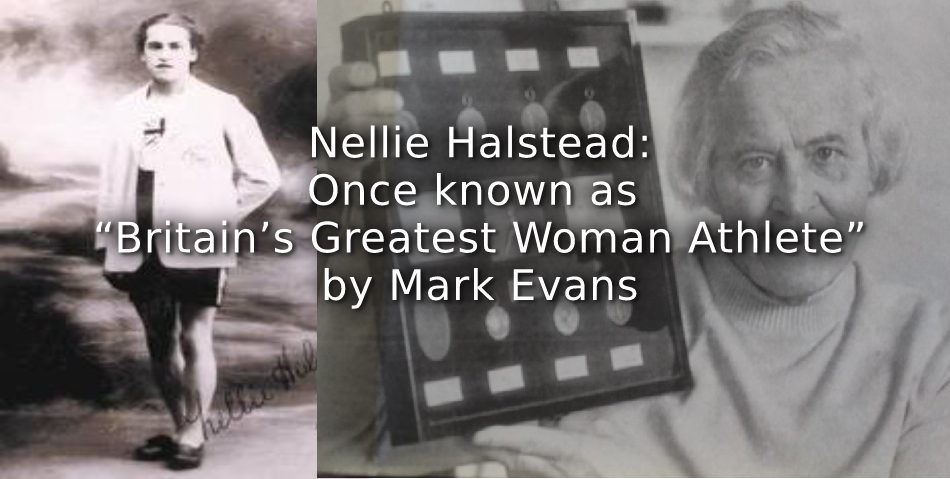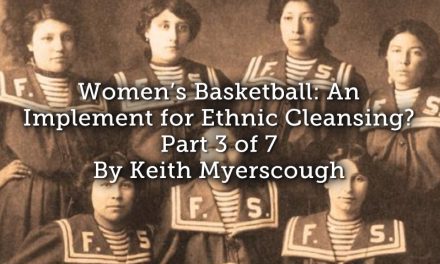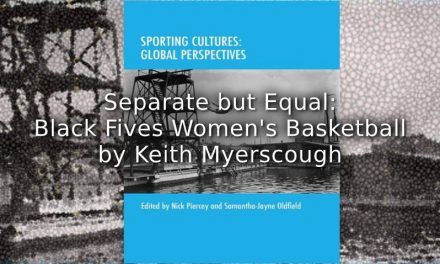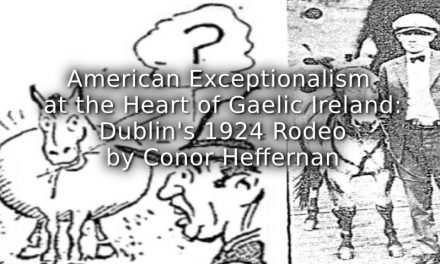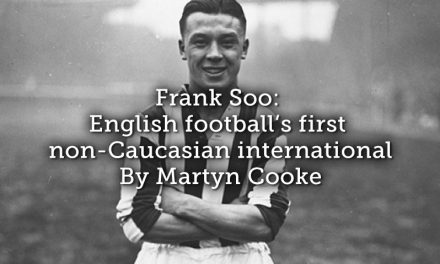I was recently reading part two of Steve Bolton’s article on Manchester Ladies F.C. on the Playing Pasts website. [Click HERE to read] I saw the reference to Nellie Halstead and I thought it was high time an article was written about the woman once known as “Britain’s greatest woman athlete”.

Nellie Halstead
Nellie Halstead was born in Radcliffe, near Bury, on 19th September 1910. The 1911 Census shows her living at 2, Nursey Brow, Chapelfield, Radcliffe, with her family. Her father, Charles, was a carter and was born in Radcliffe and her mother, Florence Anne, was born in Worcestershire. Nellie had 1 brother, Frank, and two sisters, Edith and Ethel. She also had 3 step brothers, George, Jack and Fred Dawson, and two step sisters, Amy and Eva. [Ref 1]
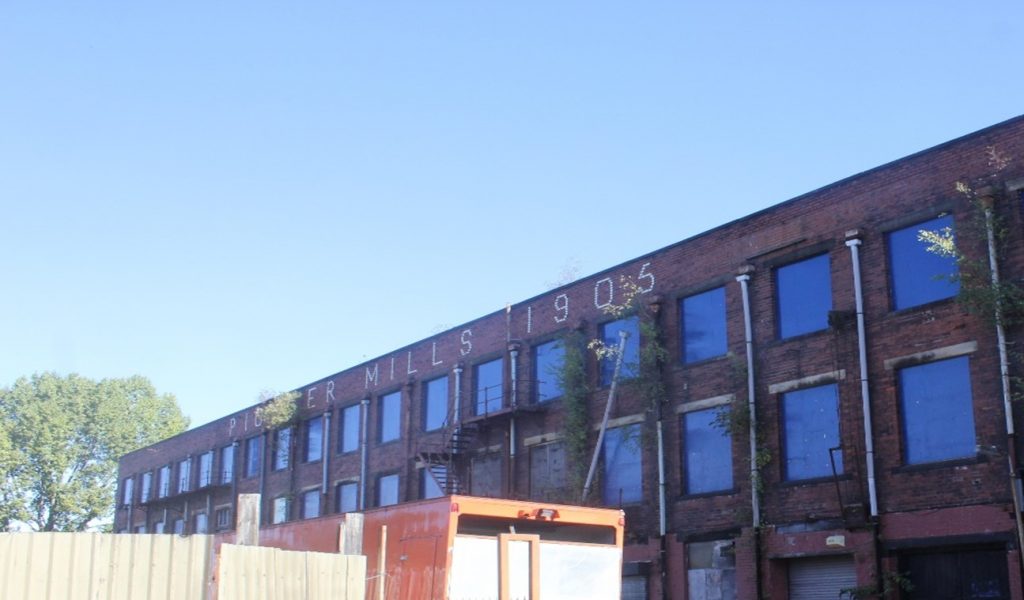
Pioneer Mills Radcliffe, built in 1905, as it looks today
One of the places Nellie used to work
Photograph – Mark Evans
Nellie was to become one of Britain greatest female athletes and excel at athletics, football and golf but many people will not know of her achievements.
Athletics for women developed at a much slower pace than for men. In the eighteenth and early nineteenth centuries we know women took part in sports meeting held at English fairs and wakes but they had to wait until after the First World War before women’s athletics was organised on a national basis. [Ref 2]
The first women’s international meeting was held on March 10th 1921 at Monte Carlo with five countries taking part and Britain sending a team of seven women.[Ref 3] In 1922 the Women’s A.A.A. was founded and they held their first championship at Bromley. [Ref 4]
Women’s athletics was part of the Amsterdam Olympics but the W.A.A.A. did not enter as they disagreed with the I.A.A.F. who decided there would be only 5 events for women, the 100 metres, the 800 metres, 4 x 100 metres, the high jump and the discus. [Ref 5]
Luckily for Nellie her athletic career coincided with the early growth of women’s athletics and she completed at the 1930 World Games in Prague, the 1932 Los Angeles Olympics and the 1934 Empire Games in London.
Using the British Newspaper Archive site, the little information that is available about her on the internet, information from Bury Archives and an important find uncovered during my research for this article, we can put together an account that will help to inform more people about her skills and achievements.
Nellie had an interesting working life working firstly at Pioneer Mills in Radcliffe as a weaver and then as her athletic career began to blossom working part time at a local brewery. She also worked for Mather and Platt’s, Radcliffe, as a welder and on Radcliffe market at one of the stalls, a cheese and salad stall, where she would often help out. [Ref 6 ]

Radcliffe Market as it looks today
Nellie once worked at one of the stalls at the market
Photograph – Mark Evans

Nellie in what is thought to be a Bury A. C. vest with some of her trophies
Newspaper clipping from the Jack Branagan collection, probably Bury or Radcliffe Times
Her running career began in the late 1920s and early 1930s. She ran initially for Bury Athletic Club and then Radcliffe Athletic Club. At Bury her coach was George Scaife who coached her in all her events. [Ref 7]

1931 WAAA quarter mile [Ref 8]
The Manchester Evening News had a feature entitled ‘My Most Dramatic Sporting Moment’ and in March 1939, Councillor Mrs. R. Taylor, who signs the article as the honorary secretary of the Northern Counties Women’s A.A.A., recalled the eventful day and the months running up to the event and the role she had to play in Nellie’s 1931 success. It makes interesting reading,
My Most Dramatic Sporting Moment – No. 39
LANCASHIRE GIRL’S TRIPLE WIN STAGGERED ATHLETIC WORLD
‘Months of careful planning had been spent before the Women’s Track Championships in London that July afternoon, and as women’s captain of Bury Athletic Club I was in charge of Nellie Halstead, whose excellent preparation decided us to enter her for the 100, 220 and 440 yards titles.’
Electrifying Dash
I went to considerable trouble in London to get the programme altered to suit us.
Outside the sun was beating down. The dressing room was hot and stuffy so I had Nellie under a table on the ground for light massage and rest between events!
Off she sped in the first event. The 100 yards was hers in 11.40sec. Then an electrifying dash in the 440 yards, which she won the world record in 58.80 sec.
The suspense of the last half hour was terrible, as I wondered if she could accomplish the treble. Keeping calm, preventing others bothering her, and concealing my own anxiety was a task.
Last event of the day – the 220!
Nellie was off, fighting for the lead, but she became unbalanced. Then I let out a last despairing yell in the straight to get up and the perfect running machine responded, to win a thrilling race in 25.50 secs.
The plan had succeeded. Nellie Halstead had done what no women in the world had ever done before and had staggered the whole athletic world……[Ref 10]
Exactly what ‘get the programme altered to suit us’ means is not clear but it seems the Bury A. C. women’s captain had some influence.
Nellie proved this was no flash in the pan as she constantly ran well at these championships. In 1932, already knowing she had been picked for the 1932 Olympic Games she competed in the 440 yards and again broke the world record. This time by two seconds winning the event in 56 4/5 secs. [Ref 11] She also retained her 220 yards title winning in a time of 25 3/5 secs. [Ref 12]

1931 W.A.A.A. Championships at Stamford Bridge
Nellie with Miss E. E. Green who won the 80 metres hurdles in a world record time of 12 seconds [Ref 13]
In the 1933 event Nellie won the 400 metres and in 1934 she was successful in the shorter 200 metres. [Ref 15]
In the 1935 Championships, which were held at the White City, Nellie made headlines, The Sunday Mirror lead their article with the headline,
BRILLIANT MILL GIRL RUNNER SMASHES ANOTHER RECORD!
Wonderful Nellie Halstead wins 800 Metres at Women’s Big Meet
The report said it was her first race at 800 metres and not only did she win it but she broke the British record recoding a time of 2 minutes 15 3/5 seconds,
‘Miss Halstead is already the holder of the 200 metres championship record, the 400 metres and 440 yards British records, in addition to the three miles cross country championships. [Ref 16]
The Sheffield Independent also noted Nellies achievements and went on to say,
‘Miss Halstead is a wonder runner. She has won the 800 metres in the British record time of 2 mins. 15 3-5 secs., and has now won National Championships over every distance, and has created records in nearly all of them. She can box, wrestle, kick a football, and play cricket. Sleep is her big training secret. Before an important race, when she is not at work, she spends all her time in bed.’
She started her running career five years ago and keeps her medals in boot boxes. [Ref 17]
The article mentions her prowess at a number of sports and as we shall she later after her running she became a very successful footballer.
In 1938 event, she was due to compete in the 800 metres but there was some kind of mix up at the start, as a report in the Reynolds News noted. Nellie had lined up for the start of the race but an announcement said that Nellie would not be running. The start had to be delayed while the track officials decided if Nellie could run. Eventually, it was agreed she could run and she went on to win the race defeating Olive Hall in an exciting finish, although in a relatively slow time of 2 minutes, 20.4 seconds. [Ref 18]

Nellie in action in a 200 metres race in Florence in 1931 beating the German athlete Dollinger
Newspaper Clipping from Jack Branagan – probably Bury or Radcliffe Times
She competed in a number of international championships. In 1930, at the start of her athletic career, Nellie competed in the third Women’s Olympiad in Prague. The first had been in Paris in 1922 and the second in Gothenburg in 1926. The Northern Whig newspaper noted that,
‘Great Britain suffers under the handicap on account of the fact that its team has to rely on voluntary subscriptions to defray the expenses of the journey to Prague, so that only 16 competitors could be secured, whereas other competing teams obtain subsides from their Governments in order to enable them to participate in the contests at full strength.’ [Ref 19]
Nellie ran in the 200 metres and finished third in a time of 26.0 seconds. The United Kingdom team had a relay team which finished second but Nellie did not feature. However, Ethel Scott did run and she is thought to be the first black women to represent Great Britain in an international athletics competition. [Ref 20]
Nellie competed at the 1932 Olympics in Los Angeles and along with the other members of the team was sent off to the U.S.A. with messages from the King and the Prince of Wales. The King wrote,
‘I know whatever the results may be you will display that pluck and good sportsmanship so traditional of the British race.’ [Ref 21]
The journey to the Games was long with a cross Atlantic voyage on the ‘Princess of Britain’ and then a train journey from New York to Los Angeles. A bit different from travel these days but as we shall see later, one that Nellie enjoyed immensely.
The women’s athletic team only consisted of five women, Nellie (Bury A.C.), Ethel Johnson (Bolton Harriers), Gwendoline Porter (London Olympiade), Violet Webb (Polytechnic A. C.) and Eileen Hiscock (London Olympiade) who was also the team manageress. [Ref 22]
Nellie was part of the women’s 4 x 100m relay team that took the bronze medal in a time of 47.6 behind the U.S.A. 46.9 (a world record) and Canada (47.0). The team being Eileen Hiscock, Gwendoline Porter, Violet Webb and Nellie. [Ref 23]
Nellie had some interesting thoughts on the Games as a report in the Daily Mirror noted,
“If English women athletes had the encouragement and help, which are given to American and Continental girls they would beat the world.” said Miss Halstead
She declared that she was dazzled by the magnificence of American athletic stadiums and impressed by their thoroughness when preparing for world contests.
“No wonder they lead the world in many sports,” she said. “When a girl shows signs of becoming a champion she is trained and ‘nursed’ like a boxer. The finest coaches are engaged for the training centres and the dressing rooms are like palaces.”
The reason for our comparative failure in women’s athletic events in the Olympic Games, according to Miss Halstead, was the little time allowed over there before the contests. The heat was terrible and the change too sudden. [Ref 24]
On her return to Radcliffe it was reported ‘ten thousand’ people joined Nellie in a civic reception. [ref 25]
In the 1934 Commonwealth Games held at White City, London, Nellie ran in three events picking up a medal in each. In the 220 yards she finished third in a time of 25.6 behind her teammate Eileen Hiscock and Canadian Aileen Meagher. She also ran in two rarely run relays. The 440 yards relay, consisting of three runners in which she ran 220 yards and Eileen Hiscock and Elsie Magurie both ran 110 yards. They finished in a time of 49.4 to secure the gold medal. A couple of days earlier she ran in the 660 yards relay and along with Eileen Hiscock she ran 220 yards while Ethel Johnson and Ivy Walker both ran 110 yards. They finished runners-up to the Canadians. [Ref 26]
Nellie’s sister Edith also competed at White City Commonwealth Games finishing 2nd in the javelin with a throw of 30.94 metres. In a note about the event in Bob Phillips’ book, The Commonwealth Games. The History of all the Sports’ it says
‘Note: Edith Halstead was later pronounced to have been a male from birth and as Eddie Halstead became a father.’ [Ref 27]

Sign at the gate entrance to the Nellie Halstead track – a little overgrown and in need of some attention
Photograph – Mark Evans
Nellie achievements in athletics were fantastic and I have only listed a few, but what I think is remarkable about her athletic talent was the range of distances she ran and the success she achieved in each event. This is highlighted in the fact that alongside her sprinting feats she ran cross country and won the women’s national cross country title twice. She also ran in the first women’s England v Scotland international cross country race.
In the 1935 National Cross Country race, now competing for Radcliffe, she beat the five times holder, Miss L. D. Styles, by 11 seconds at Longbridge, Birmingham. It was reported that she entered,
“just to keep my clubmates company, never dreaming of winning” [Ref 28]
Her victory meant she would represent England in the first women’s international cross country race between England and Scotland at the Old Golf Links, Morecambe. The course was over three miles and the going was heavy. Nellie lead the English home finishing first in 20 minutes and 6 seconds, followed by Miss Styles and Miss Raven. The Morecombe Guardian reported,
‘The race was run at a strenuous pace, and several of the competitors were overcome at the end and had to receive attention.
The first three runners, particularly Miss Halstead, finished in a remarkably fresh condition.’ [Ref 29]
In the following year she won the Northern Cross Country Championship at Norton, Sheffield, on a course covered in snow. [Ref 30] In the National, held at Chigwell Row, Essex, Nellie again defeated Miss Styles, and defended her title covering the three mile course in 22 minutes and 12 seconds.

The Nellie Halstead track, Radcliffe, as it is today – not in the best of conditions
Photograph – Mark Evans
Why did Nellie switch from Bury A.C. to Radcliffe A.C. the answer can be found in a Daily Herald article from 1933 which explains that Nellie wanted to run with the men when she was training, however the Bury Athlete Club would not allow this and both Nellie and her sister Edith left and moved to Radcliffe A. C. A quote from an official of the Northern Counties Women’s Athletic Association said,
‘We felt that the spirit of athletics for women would be spoilt if we allowed women, however brilliant, to train with the men. Women have made their own standards and have their own organisation and code of rules. We understand Miss Halstead’s point, but we cannot alter our principles.’
This incident shows how different things were in Nellie’s day and that in relation to men’s sport and women’s sport there were many issues that must have kept committees and governing bodies awake at night. I have not been able to find out if Nellie was allowed to train with the men at Radcliffe but it would be interesting to find out! [Ref 31]
Radcliffe Athletic Club still remember Nellie as they have an annual award known as the Nellie Halstead award which is awarded to the women who has shown exceptional achievement in competition. The 2022 winner was Sheila Jones. [Ref 32]
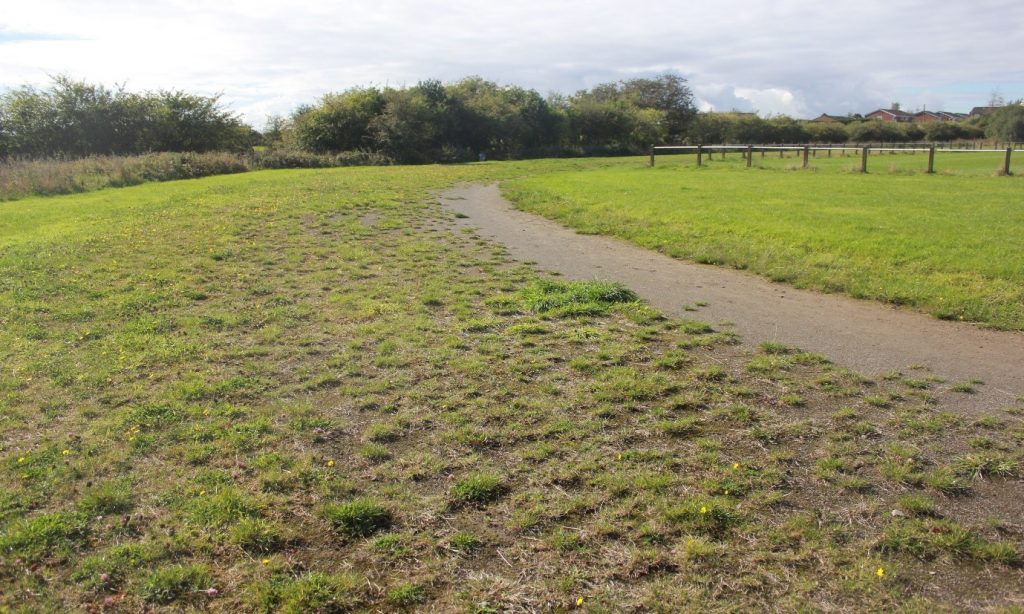
One of the bends at the Nellie Halstead track
Photograph Mark Evans
Nellie is remembered in her home town of Radcliffe with an athletic track named after her. Although Radcliffe Athletic Club, one of her former clubs, did use the track it has now become disused and is in a state of disrepair. Interestingly, the centre of the track was used by a local football team and I suspect that they did not realise that Nellie was once at the forefront of women’s football at a time when it was believed by many people that women should not be playing football.
She played football for Bolton Women’s Football Club and was to captain the England women’s football team. Although, I have not been able to find as many articles on her football career as her athletic career it is clear from the ones I found she was an outstanding player.
It is not known when she started playing football but she was playing for the Bolton Women’s team in the winter of 1939. She was a prolific goal scorer, helped I am sure, by her pace. In a match against Preston Ladies on 25th November 1939 she was one of the Bolton goal scorers as they drew 3 – 3. [Ref 33] One of the scorers for the Preston team was Margaret Thornborough, a highly regarded hockey player, who played for Whittingham Hospital and was known for her hockey goal scoring achievements.
The Merthyr Express from August 1941 reported on an England v Wales match held at the Recreation Ground, Tredegar, Wales,
‘The English team was captained by Nellie Halstead of Radcliffe, the world’s quarter-mile champion’
Also in the team were two Dick Kerr’s players, S. Owen and Annie Lynch. The match was to boost the funds of the War Services Committee and the Tredegar British Legion, a popular reason for women’s football games around this time. The match finished in an easy win for the English team, 9 – 0. [Ref 34]
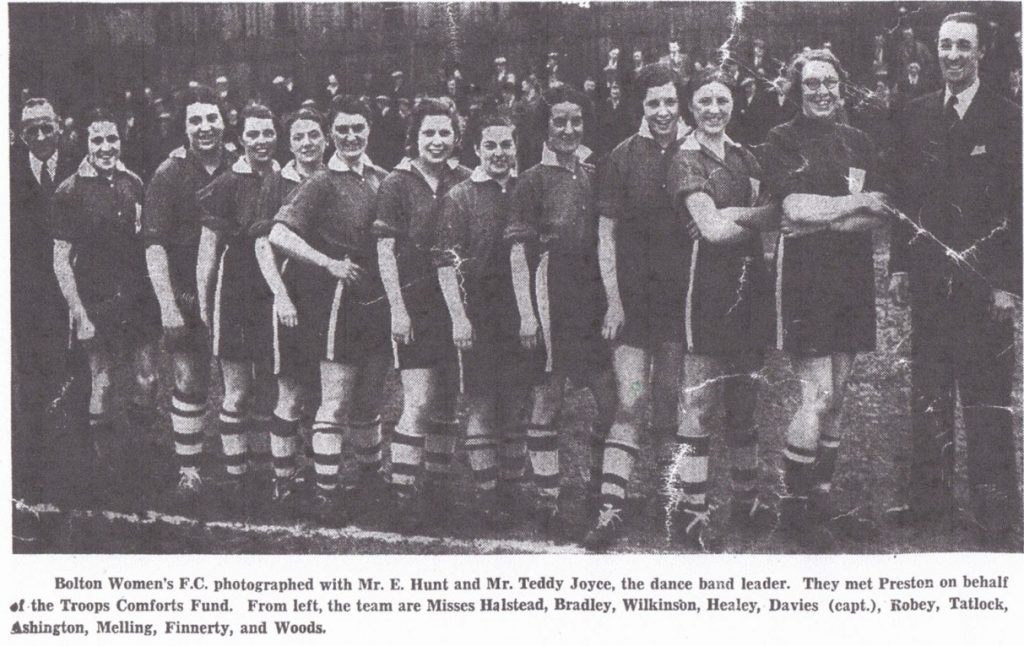
The Bolton Woman’s F.C. team who played Preston on behalf of the Troops Comforts Fund
The team also included Mary Tatlock, who was the England Hockey goalkeeper between 1954 and 1960. Mary was from Farnworth, near Bolton.
Steve Bolton in part 2 of his ‘Manchester Ladies FC’ ‘Playing Pasts’ article says the above photograph is from a match played on Christmas Day 1940 at Leigh. 35 It appears Bolton were regular opponents of the Preston team and Nellie was one of their star players. In her book ‘In a League of Their Own! The Dick, Kerr Ladies 1917 – 1965’, Gail Newsham, says that,
‘Just as before the war, Bolton Ladies, particularly with the speed of Nellie Halstead, were proving tough opposition and were victors in some of their meetings.’ [Ref 36]
In fact, Steve says that in the game at Leigh, Bolton beat Preston 12 – 2, although for some reason Preston played with only 10 players. Nellie scored 7 of the Bolton goals. [Ref 37]
In 1946 Nellie was in a Bolton Ladies’ F.C. team who played against Preston Ladies F.C. in a charity match at Fullwood Barracks, Preston in aid of the Preston and Fulwood Thanksgiving Fund. Preston were captained by the famous Lily Parr. In the newspaper report I found it only gives the half time score, 3 – 1 in favour of Bolton. [Ref 38] Steve, though, confirms the score was 9 – 3 for Bolton with Nellie again scoring 7 goals. The match was watched by a crowd of over 3,000. [Ref 39]
It appears Bolton Ladies F.C were a successful team and one of the best teams in the country. A report in the Burnley Express from 1947 says that the Chief Constable, Mr W. Green, had arranged a match between Preston Ladies and Bolton Ladies in aid of the Police Youth Club. It notes that the two teams,
‘….are keen rivals and are considered the best elevens of their kind in the country. The only occasion Preston (successors to the famous Dick, Kerr’s Ladies) have been defeated was when they met Bolton last year and they are eager to turn the tables…………..Bolton have the proud reputation of not being beaten during the last six years……..Their centre forward is Nellie Halstead who gained championship fame as a runner in many international events’ [Ref 40]
I am aware that further research needs to be conducted to fully appreciate Nellie’s football career but the above gives a glimpse of her influence on the Bolton team and in some respect in women’s football in general.
Nellie was also a keen golfer and played at Lowes Park Golf Club near Bury and in one of those coincidences that often happens when conducting research I was contacted by a running friend of mine from Bury Athletic Club who put me in touch with a gentleman called, Jack Branagan, who had been the secretary at Lowes Golf Club and owner of the stall on Radcliffe Market where Nellie often helped out. He had fond memories of Nellie and high regard for her golfing ability. He had a number of newspaper cuttings but one fantastic piece of sporting history he did have was a booklet written by Nellie herself entitled, ‘ My Trip to the Olympic Games 1932 Los Angeles’. She had signed and dated it with the following note,
To Jack
From
Nellie
21.6.91
The booklet contained 27 pages of handwritten text about Nellie’s journey to the 1932 Olympics, her time at the Olympics, an athletics meeting in San Francisco and then one in Montreal. She was able to stay in the USA with her step sister Amy and her family for a short holiday and the booklet contains an interesting summary of her stay with Amy in Brooklyn, New York. Nellie travelled back to England on Cunard’s R.M.S. ‘Mauretaina’. Also on board were the Phelps brothers who were Olympic scullers and Nellie spent time in their company on the journey back to London.
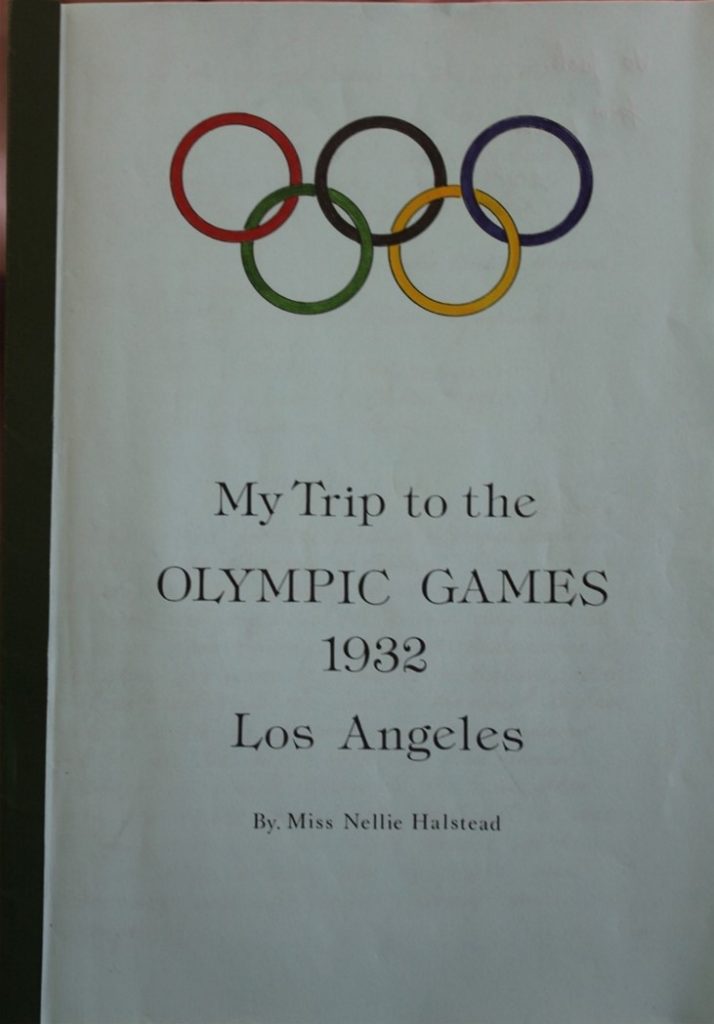
The front cover of the booklet written by Nellie about her trip to and from the 1932 Olympics
From the personal collection of Jack Branagan [Ref 41]
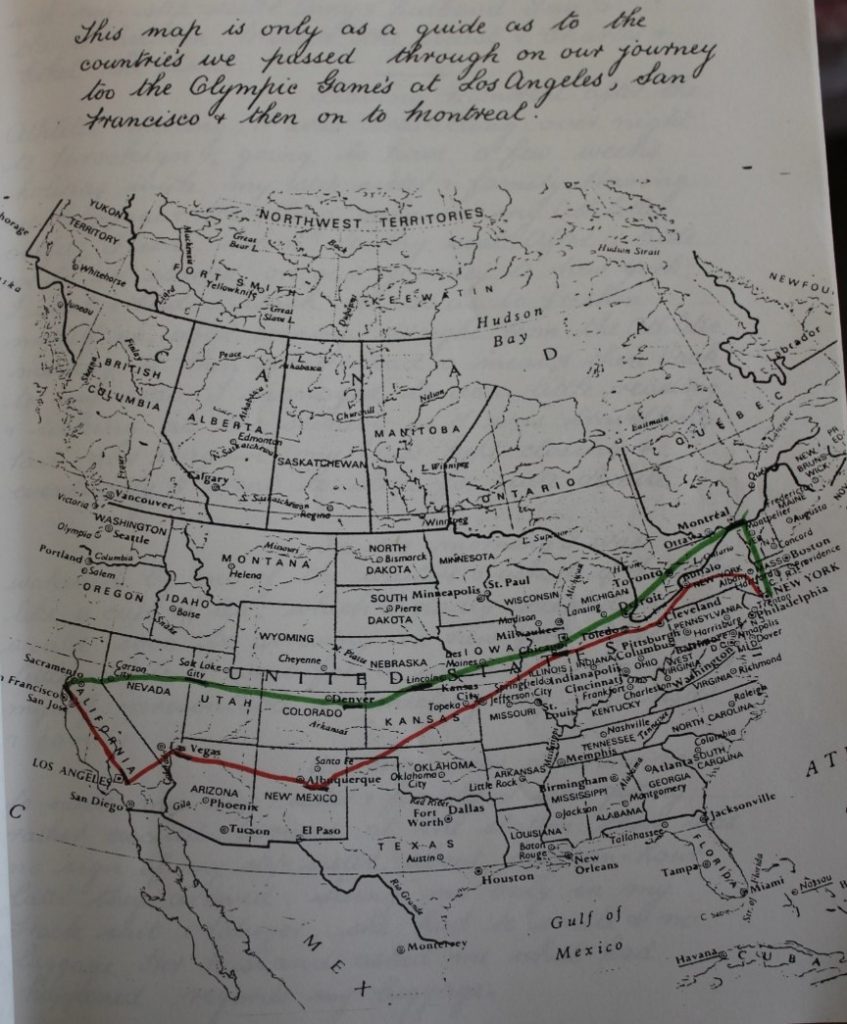
A map of Nellie’s journey to the 1932 Olympics from her booklet with a note about the route they took
From the personal collection of Jack Branagan [Ref 43]
‘The crossing to New York was good. On the fourth day out at sea, as we were having breakfast, news came to us that we were in sight of an iceberg, a few of us dashed to the side of the liner to have a look at it. To me it’s really a magnificent sight.’
……….
The train taking the British, Canadians and some of the U.S.A. Olympic team’s; to Los Angeles was called the ‘Olympic Special’. We soon became friendly with one another on the journey.’ [Ref 43]
Nellie recalls the team took part in light training until the day after the opening ceremony when they started ‘more serious training’. However, at the start of the women’s Olympic 100 metre heats Nellie notes,
‘Unfortunately one of our girls, E. Johnson pulled a muscle at the start of her heat. So she was out for the rest of the Games. That was a serious setback for us, as she was in the relay team. So we had to call on N. Webb to take her place in the relay team.’ [Ref 44]
Nellie is very brief on her account of the Olympic 4 x 100m relay just saying,
The day arrived for the final of the 4 x 100m relay. All our training in baton changing paid off in the final. For we came in third place behind Canada and the U.S.A. the winners so we were in the medals. [Ref 45]
The booklet is a fascinating insight into Nellie’s Olympic experience and her stay with her step sister. The life of a 1930’s athlete was a lot different to an athlete of today!
Intriguingly, I found a report in the Bury Guardian, from 1931, indicating that Nellie may also have played hockey. The paper regularly reported on the Bury and District Ladies’ Hockey League and in the May 9th edition there was a reference to the matches to be played that day. Often the team lists were displayed but in this report there only seemed to be one team list and only one player listed,
‘Heywood St James v Radcliffe Cong. – Miss N Halstead’ [Ref 46]
I need to conduct more research into this. However, it would not surprise me if Nellie did play hockey. Margaret Thornborough, mentioned above, was very successful at both hockey and football and during my research into women’s hockey leagues, it is clear women often played football and hockey and I have no doubt that Nellie would be able to turn her hand to any sport. As football was not played all the time a great way for the women footballers to keep fit would be to play hockey. There was a well developed league structure in hockey in many of the Northern industrialised towns at this time and competitive games were held throughout the winter.
Nellie died on 11th November 1991, aged 81, in Bury General Hospital following a stroke. A plaque was placed in Radcliffe Crematorium.

Nellie’s plaque at Radcliffe Crematorium
Photo – Mark Evans
- Two pages from Nellie’s booklet listing some of her athletic achievements
- Jack Branagan personal collection [Ref 47]
Nellie Halstead was a remarkable athlete and as time passes and people’s memories fade her achievements are forgotten. When she was given the title of ‘Britain’s greatest women’s athlete’ I am sure at the time she was, however, time has moved on and there are many who could now claim the title. Sports historians are now uncovering stories about a number of multi-talented women who were successful at a number of sports, but, I think you will agree they would have to go a long way to better Nellie’s achievements.

Nellie with some of her many medals [Ref 48]
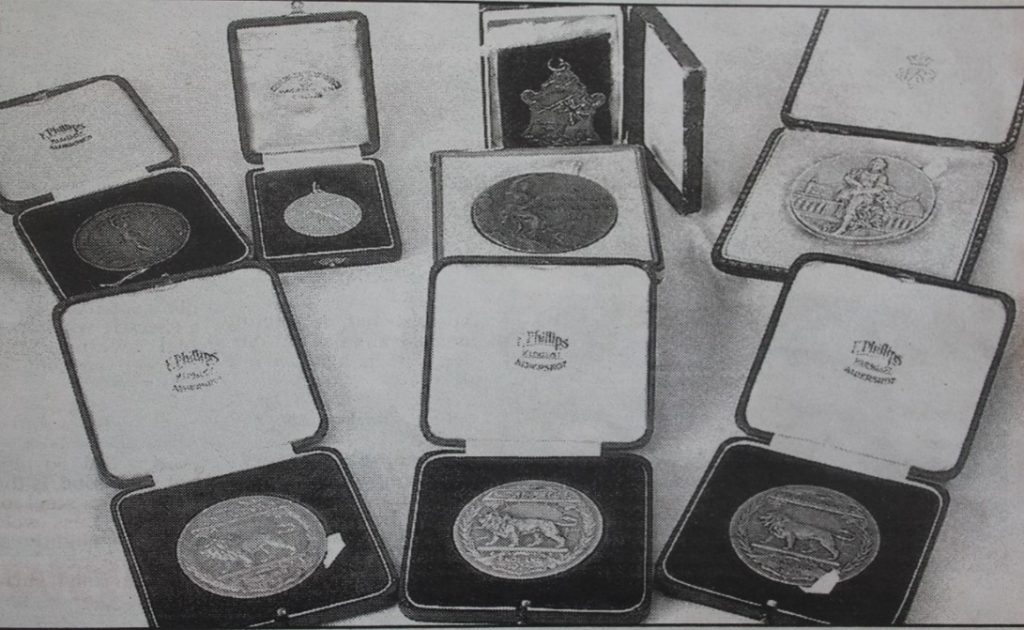
Some of Nellie’s prized medals, including her Olympic bronze medal [Ref 49]
References
- Ancestry
- History of British Athletics, Melvyn Watman, 1968
- Ibid
- Ibid
- Ibid
- Radcliffe Athletic Club website
- The Bury Guardian, May 9, 1931 p11
- The Illustrated Sporting and Dramatic News, July 18, 1931 p143
- Ibid
- Manchester Evening News, Wednesday March 1, 1939 p4
- The (Dundee) Courier and Advertiser, Monday, July 11, 1932 p10
- The Aberdeen Press and Journal, Monday July 11, 1932 p5
- The Illustrated London News, July 18, 1931 p112
- Aberdeen Press and Journal, Monday, July 11, 1932 p10
- com website
- Sunday (Mirror) Pictorial, August 11, 1935 p39
- The Daily Independent (Sheffield), Monday, 12 August,1935 page 9
- Reynolds News, July 3, 1938 p19
- The Northern Whig and Belfast Post, Saturday, September 6, 1930 p11
- Website – blackplaqueproject.com
- The Scotsman, Monday, July 11, 1932 p16
- Ibid
- The Complete Book of the Olympics, David Wallechinsky, 2000
- The Daily Mirror, Thursday, September 22, 1932 p23
- The Western Times, Friday, September 23, 1932 p16
- ‘Honour of Empire, Glory of Sport, The History of Athletics at the Commonwealth Games’ Bob Phillips, 2000. p25
- ‘The Commonwealth Games. The History of all the Sports.’ Bob Phillips, 2002 p99
- The Daily Independent, Monday, 4 March, 1935 p9
- The (Morecombe) Guardian, Friday 26 April, 1935 p11
- The Daily Independent (Sheffield), Monday 2 March, 1936 p10
- Daily Herald, Friday, February 3, 1933 p15
- Bury Times, Thursday, December 15,2022 p62
- The Lancashire Daily Post, November 25, 1939 p6
- The Merthyr Express, August 9, 1941 p 3
- ‘Manchester Ladies F. C. – Post WW2 Pioneers My Tribute to the Great Marian Bindotti RIP Part 2’ – Steve Bolton ‘Playing Pasts’ website, August 29, 2022
- ‘In a League of Their Own! The Dick, Kerr Ladies 1917 – 1965’ Gail Newsham 2018 p195
- ‘Manchester Ladies F. C. – Post WW2 Pioneers My Tribute to the Great Marian Bindotti RIP Part 2’ – Steve Bolton ‘Playing Pasts’ website, August 29, 2022
- The Lancashire Daily Post, July 20, 1946 p4
- ‘ Manchester Ladies F. C. – Post WW2 Pioneers My Tribute to the Great Marian Bindotti RIP Part 2’ – Steve Bolton ‘Playing Pasts’ website, August 29, 2022
- Burnley Express and News, July 26, 1947 p7
- ‘My Trip to the Olympic Games’, Nellie Halstead (Jack Branagan Collection), front cover
- , p9
- , p2
- , p4
- , p5
- Bury Guardian, May 9, 1931 p11
- ‘My Trip to the Olympics’, Nellie Halstead (Jack Branagan Collection) no page number
- Radcliffe Times, Thursday, June 11, 1998 p14 (Jack Branagan Collection)
- Radcliffe Times, Thursday, June 11, 1998 p14 (Jack Branagan Collection)

